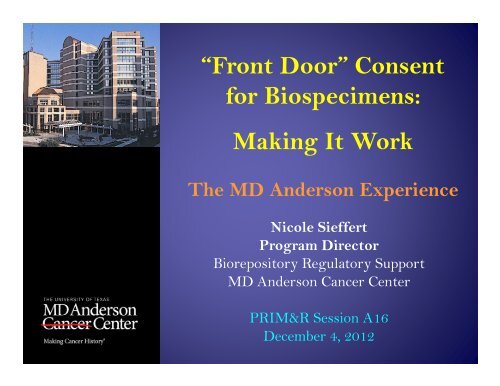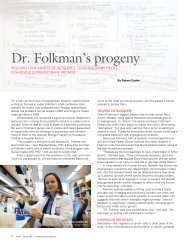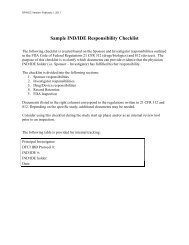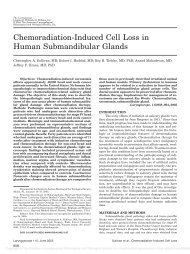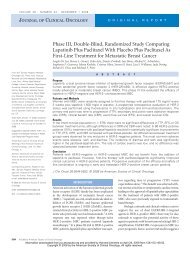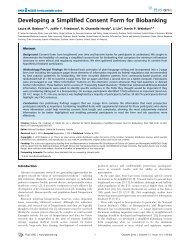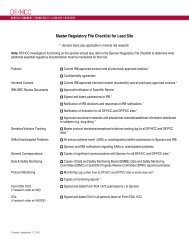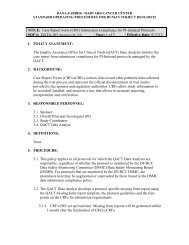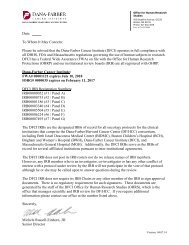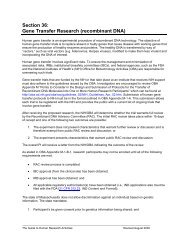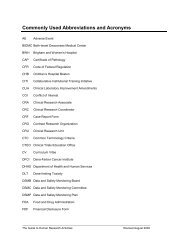âFront Doorâ Consent - Dana-Farber/Harvard Cancer Center
âFront Doorâ Consent - Dana-Farber/Harvard Cancer Center
âFront Doorâ Consent - Dana-Farber/Harvard Cancer Center
- No tags were found...
You also want an ePaper? Increase the reach of your titles
YUMPU automatically turns print PDFs into web optimized ePapers that Google loves.
DisclaimerThe viewpoints i expressed herein represent thepresenter’s personal perspectives and are notnecessarily those of MD Anderson <strong>Cancer</strong><strong>Center</strong>.
The MD Anderson Biorepository• Federated system of 26 Satellite (specialty) Banksand 1 Central Institutional Bank• Prospective, targeted biospecimen and related datacollection• General, unrequested collection• Assisted protocol-specific pclinical collection• Segregated specimen / data storage• Segregated distribution of repository resources forsecondary use• Assistance with distribution of FFPEBs for research• Oversight via Biorepository Regulatory Support (BRS)
M.D. Anderson <strong>Cancer</strong> <strong>Center</strong>Institutional Tissue Banking SystemSerum-BreastCaHematopathNon-MelanomaSkinLeukemiaPancreasPediatricsNeurologyKidneyProstateMelanomaBoneHead &NeckSerum/PlasmaInstitutionalTissueBank (ITB)Human<strong>Cancer</strong>GeneticsSoftTissueSarcomaGynecologyThoracicCytologyLowerGIUpperGILymphomaGUBladderBreastEndocrineGynEndocrineNeoplasia
Institutional Tissue Bank StructureInstitutionalBiospecimenUseCommittee(IBUC)Division of Pathology &Laboratory MedicineDirectorLaboratory ManagerTissue Procurement SpecialistsBiorepositoryRegulatorySupport(BRS)BiorepositoryInformaticsSatelliteIndividualSurgical andNon-surgicalTissueStationBloodBanks Investigators Tissue Database SpecimensSpecimensQualityControlActivities
Typical Satellite Bank StructureDirectorCo-DirectorInformed <strong>Consent</strong>• “Front-door”• Bank SpecificCoordinator / AdministratorHistotechs andResearch AssistantsSatellite BankCommitteeClinico-pathologicalDatabaseTissue StationSamplesDatabaseSurgical andNon-surgicalTissueSpecimensCytologySpecimensBloodSpecimensQualityControlActivitiesFormalized over the course of the last 15 years
In the Beginning….•Notissue collection protocol• Tissue collection = the “buddy” system• <strong>Consent</strong> = part of <strong>Consent</strong> to Treat & Diagnose• No communication between patient registration, clinicaland lab, & research personnel re: tissue bankingNew Millennium Changes2000 – 2001 - First “Front Door” <strong>Consent</strong> (FDC)• Operational ITB (1999)• No tissue collection protocol (& still no communication)• Single page paper consent document provided in patientpacket during centralized patient registration process•Nocentralized response tracking mechanism• <strong>Consent</strong> confirmation via visual document inspection
The FirstInstitutional Banking ProtocolPurpose:• To fully establish the ITB2003• To further Satellite Bank development• To provide assistance in planning for & coordinatingtissue, fluid, & related data use by MDACC InvestigatorsContent:• Request to collect and hold residual tissue, fluids, andrelated data for future cancer research• All patients eligible (regardless of diagnosis history ageAll patients eligible (regardless of diagnosis, history, age,etc.)
<strong>Consent</strong> DocumentMoving Forward (2003)…..• Paper document provided by research/clinical staff in specialty centers• Scanned into EMR for viewing (undependable)• Valid until revoked• Responses documented in a single electronic database• No standard for handling revocations• No assentCommunication• Limited, regarding document changes onlyOperations• ITB and SBs = primary collectors• Individual PIs encouraged to request waivers to “lean on” FDC
Today’sInstitutional Banking Protocol• Collects only residual tissue, fluids & associateddata for future use in cancer-related research• Updated to include details regarding• Minor assent• <strong>Consent</strong> admin. & revocation methods• Data collection requirements• Specimen utilization requirements• Oversight
Today’s “Front Door” <strong>Consent</strong>• Exclusive electronic consent administration (2006)• At registration in specialty centers (specialized training required)• In the Preop Anesthesia Clinic• In the clinical setting upon request• Limited language use (technical)• No short form (VTPS) use• Instantly readable / printable documents within the EMR• Real time consent database• Real time updates (i.e., revocation)
Today’s “Front Door” <strong>Consent</strong>Administration• 2,300 (avg.) consent documents completed per month• 97% “Yes” response rate• Tissue use protocol required with IRB-granted Waiver of<strong>Consent</strong> &A Authorization i for specimen/data distributionib iTraining• 4 hours, in 3-parts• IRB Video• Intro to the ITB• Step-by-step “how-to” &roleplay• Full instructions & quick reference pocket guideQA/QC• Monthly automated / manual audit report• Direct correspondence with admins & supervisors• In-service = annual & PRN
Where is MDACC headed next?• Centralized inventory tracking/data management• Global l protocol and consent to include non-residualand autopsy tissue• Clinical grade collection to enable return of researchresults• Video introduction to tissue banking
Making “FDC” Work at MDACCTOP CHALLENGES1. Putting the IRB at ease (HIPAA, genetic research, oversight)2. Reaching a large patient population at >30 points of entry3. Tracking consent responses (including reconsent & revocation)and making that information accessible to research staff• Verification at collection, use, distribution4. Assuring appropriate collection and equitable distribution• Buy-in (Administration, Pathology, Surgery, Clinics, Legal)• Multiple requests for limited tissue / Tissue silos / Protocol stacking5. Maintaining funding• CCSG / Charge-back mechanism, grant sharing
Could “Front Door” <strong>Consent</strong>Work for You?What regulatory challenges exist?What institutional cultural challenges exist?What logistical challenges exist??Consider these questions…….
Where will you start?With a blank slate?With existing resources?Think space, equipment, personnel& $$$Where would you like to be?
Only the right protocol, people, and processes will make it work.Remember…….-What you do has to suit all stakeholders-Existing systems can be barriers(think of them as a challenge!)IRBInstitutionalLeadershipInstitutionalResearchersBiorepositoryStakeholdersCommunity /StakeholdersOtherPatientsBiobanksFundingAgenciesOutsideResearchers
Address Financial / SustainabilityConcerns• Institutional support from• Institutional Administration (marketing, overhead)• IRBs / ECs• Pathologists / Surgical / Clinical staff?• Community vs. specialty facility• Grant and other award-based dependence?• Join forces with existing consent administration staff?• Market the effort to the benefit of all-institution research• Reference in protocols, CDs and publicationsWill b d t ( id l l )• Will broad consent (non-residual samples) =collection and support?
Regarding the Informed <strong>Consent</strong>Document…• When & where will it be administered? By whom?• Paper only, electronic, or both?• How are responses documented and communicated?• How is revocation handled?• Documentation• Informing biospecimen custodians• Patient confirmation
Designate FDCLocation & TimingiCan you….• Adequately train, monitor and address issues asthey arise?• Reach the targeted patient population withoutbias (equal access to all areas)?• Function a part of and without interruption ofclinical patient flow?
Staff Training Program?• Peer-based vs. formal• Human Subjects Research• Clinical vs. research vs. admin. staff• Customer service• In-service frequency
What Works Bestfor Everyone?Photo by: AmbroLong-term planning& regular reviewPhoto by: PhotostockContributorcollaborationTeaching +Getting & keepingthe right peopleinvolved
Nicole SieffertProgram DirectorBiorepository Regulatory SupportMD Anderson <strong>Cancer</strong> <strong>Center</strong>1400 Pressler Street, Unit 1435Houston, TX 77030(713) 563-3526 3526 Office(713) 563-9586 Faxnsieffer@mdanderson.org
PanelDiscussion


